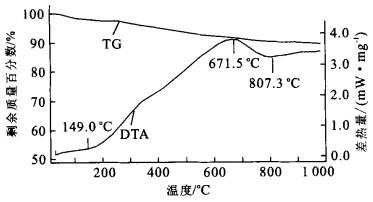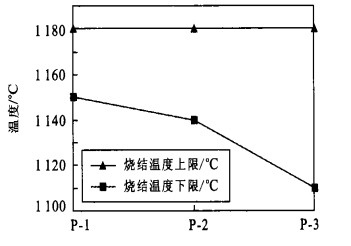Experimental Studies on Porcelain Brick Preparation Using Lake Bottom Sediments and Coal Fly Ash
-
摘要: 将湖泊底泥引入瓷质砖的生产, 既可消除污染, 又能减少传统的瓷质砖生产中所需的粘土.以武汉市东湖底泥和湖北黄石电厂粉煤灰为主要原料, 辅以伟晶花岗岩、石英为添加剂, 设计4个底泥含量分别为4 0 %、5 0 %、6 0 %和70 %的配方, 每一配方压制6片生坯, 分别在1 190, 1 175, 1 160, 1 130, 1 115和1 100℃下烧成.XRD分析显示瓷坯中的莫来石晶相随烧成温度的升高而增加.在1 160~1 175℃烧成的瓷坯的吸水率和断裂模数测试结果分别为0.0 8%~ 0.2 0 %和39.36~ 51.0 8MPa, 表明利用湖泊底泥和粉煤灰作为主要原料可以烧制瓷质砖, 二者的总用量可达75 %~ 80 %.Abstract: The exploitation of lake bottom sediments as raw materials of porcelain brick is believed to be profitable, eliminating the water pollution and reducing the consumption of clays employed in tranditional brick industry. Porcelain bricks were prepared using the bottom sediments from the East Lake in Wuhan and coal fly ash from Huangshi in Hubei as main raw materials, and granitic pegmatite and quartz as additives. Four mix-designs with 40%, 50%, 60% and 70% of the bottom sediments were tested under different sintering temperatures ranging from 1 100 to 1 190 ℃. XRD analysis indicates that the content of mullite in the porcelain bricks increases with the sintering temperature. The water absorption, rupture modulus of all porcelain bricks of the samples sintered at (1 160) and (1 175 ℃) are respectively 0.08%-0.20% and 39.36-(51.08 MPa). The results show the practicability to produce porcelain bricks using lake sediment and coal fly ash with a sum of 75%-80%.
-
Key words:
- East Lake /
- substrate sediment /
- coal fly ash /
- porcelain brick
-
表 1 原料的化学成分
Table 1. Chemical compositions of raw materials

表 2 底泥和粉煤灰的掺加量及各配方的理论化学组成
Table 2. Content of lake sediment and coal fly ash, and theoretical chemical compositions of mix-designs

表 3 配方P-1、P-2和P-3瓷坯的吸水率和断裂模数
Table 3. Water absorption and rupture modulus of porcelain bricks of P-1, P-2 and P-3 mix-designs

-
Canet R., Chaves C., Pomares F., et al. 2003. Agricultural use of sediments from the Albufera Lake(eastern Spain). Agriculture, Ecosystems and Environment, 95: 29-36. doi: 10.1016/S0167-8809(02)00171-8 Chen H. L., Chen Y.X. . 2002. Progresses of remediation techniques for polluted sediment. Agri-environmental Protection, 21(2): 179- 182(in Chinese with English abstract). Chen Y.H., He L.P., Zhao X.H. . 2002. Technology on environmental dredging engineering for pollution sediment in Xingyun Lake. Yunnan Environmental Sciences, 22(2): 47-50(in Chinese with English abstract). Ferreira C., Ribeiro A., Ottosen L. . 2003. Possible applications for municipal solid waste fly ash. Journal of Hazardous Materials, 96: 201- 216. doi: 10.1016/S0304-3894(02)00201-7 Liu G.Y., Jiang P.H. . 2002. Study on importance and approaches to the reutilization of river sediment. Journal of Donghua University, 28(1): 33- 36(in Chinese with English abstract). Liu H.L., Jin X.C., Jing Y.F. . 1999. Environmental dredging technology of lake sediment. Engineering Science, 1(1): 81- 84(in Chinese with English abstract). Lǜ, B., Yang K., Hong H.Q., et al. 2002. Research on dehydration of the East Lake. China Water& Waste-water, 19(5): 56- 58(in Chinese). Tang C.B. . 1998. Analysis on the influence of bed-mud storage of Dianchi Lake on the underground water. Yunnan Environmental Sciences, 17(2): 31- 34(in Chinese with English abstract). Wang Z.P., Xu J.X. . 1999. Utilization of bottom sediment in Suzhou creek for producing ceramisite. Journal ofBuilding Materials, 2(2): 176- 181(in Chinese with English abstract). Yang L., Hu S.Y., Zhang X., et al. 2000. Research of technical for producing cement clinker with the sludge of Suzhou river. Cement, (10): 10- 12(in Chinese with English abstract). 陈华林, 陈英旭. 2002. 污染底泥修复技术进展. 农业环境保护, 21(2): 179- 182. https://www.cnki.com.cn/Article/CJFDTOTAL-NHBH200202025.htm 陈异晖, 和丽萍, 赵祥华. 2002. 环境疏浚技术在星云湖的工程化应用. 云南环境科学, 22(2): 47- 50. doi: 10.3969/j.issn.1673-9655.2002.02.017 刘贵云, 姜佩华. 2002. 河道底泥资源化的意义及其途径研究. 东华大学学报, 28(1): 33- 36. https://www.cnki.com.cn/Article/CJFDTOTAL-DHDZ200201007.htm 刘鸿亮, 金相灿, 荆一凤. 1999. 湖泊底泥环境疏浚工程技术. 中国工程科学, 1(1): 81- 84. doi: 10.3969/j.issn.1009-1742.1999.01.018 吕斌, 杨开, 洪汉清, 等. 2002. 东湖底泥的脱水性能试验研究. 中国给水排水, 19(5): 56- 58. doi: 10.3321/j.issn:1000-4602.2002.05.018 汤承彬. 1998. 草海底泥堆放对地下水的污染分析. 云南环境科学, 17(2): 31- 34. https://www.cnki.com.cn/Article/CJFDTOTAL-YNHK802.010.htm 王中平, 徐基璇. 1999. 利用苏州河底泥制备陶粒. 建筑材料学报, 2(2): 176- 181. https://www.cnki.com.cn/Article/CJFDTOTAL-JZCX902.016.htm 杨磊, 胡士跃, 张雄, 等. 2000. 利用苏州河底泥生产水泥熟料技术研究. 水泥, (10): 10- 12. doi: 10.3969/j.issn.1002-9877.2000.10.004 -










 下载:
下载:






